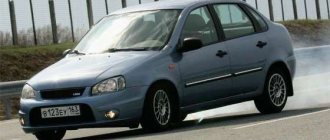Lada Largus is a popular car from the largest passenger car manufacturer in Russia, AvtoVAZ. The car is actually a Russian copy of a French car (a joint project between Renault and AvtoVAZ on the B0 platform).
The manufacturer offers the model in several versions: 5-door station wagon (five-seater), minivan, etc. Largus is equipped with four gasoline engines and manual gearboxes JH3 and JR5. Next, we will look at what features the Largus gearbox has, as well as what a manual transmission is on this car.
Lada Largus
Over time, you get used to the shortcomings of the car you drive all the time. But there are exceptions to the rules. For two years now I have been using the Lada-Largus editorial station wagon and still cannot accept the heart-rending roar of its engine on country roads. On a long journey, you get tired of this tedious monologue, and the rising tachometer needle puts pressure not only on the psyche: you constantly think about increased fuel consumption. Judging by the numerous unflattering comments on thematic Internet forums, I’m not the only one who doesn’t like the too short fifth gear. Moreover, this problem mainly concerns the most popular passenger version with a 16-valve 1.6-liter K4M engine. Different boxes and main pairs are installed on Largus (see table). And in a passenger car with a sixteen-valve engine, fifth gear turns out to be the most high-torque. Even the van speeds faster in fifth gear. Although logically it should be the other way around.
Checking the crankshaft sensor
Checking the condition of the sensor can be superficial, in which only the resistance of its winding is measured, or deep, in which all basic parameters are checked. Let's consider both types of checks:
- For a superficial check, it is enough to have only an ohmmeter. Using this device, the winding resistance is measured. This indicator may differ on different cars, but usually it is 550-700 Ohms. If during measurement the resistance reading is greater or less, the sensor is faulty.
- An in-depth test is more complex and will require a megohmmeter and an inductance meter.
A megohmmeter measures the insulation resistance of the sensor when a voltage of 500 V is applied to it; at this voltage, the resistance should exceed 20 MOhm.
An inductance meter checks the inductance of the sensor. For a working sensor, this indicator should be at the level of 200-350 MHz.
Video: Crankshaft position sensor. Examination
These sensors have a non-separable design and cannot be repaired. Therefore, if the check shows that it is faulty, then it is simply replaced.
WHAT IS GOOD?
The standard sixteen-valve box has both pros and cons. Among the advantages is the ability to provide dynamic acceleration and excellent elasticity. A car with a gross weight of nearly two tons and armed with only a 105-horsepower engine confidently stays in traffic, and in fifth gear it cheerfully picks up from 50 km/h - there is no need to shift often. On long hauls, sometimes you drive for several hours in fifth as if on automatic. It’s convenient, but you have to pay for it with increased noise and fuel consumption - and even when the speedometer needle has not even reached a hundred. Therefore, together with the specialists from our technical center, we decided to experiment with different gear ratios. After all, the design of the Largus transmission allows you to change fifth gear gears without disassembling the entire box or even removing the unit from the car. By the way, owners of Renault models (for example, Logan or Sandero), as well as Nissan-Almera, can similarly configure the top gear for themselves.
What problems arise?
The coolant temperature sensor in the Priora 16 valves, as already mentioned, is no different from others, and therefore has the same problems, methods of treating and diagnosing them.
In the event of a malfunction of the detector communicating with the instrument panel, the only signal about this will be a missing or deliberately incorrect temperature value. The cause of the malfunction may be:
- breakdown of the indicator itself on the tidy;
- wiring fault;
- failure of the detector itself.
As can be seen from the list, the breakdown is not always caused by the meter itself, but as practice shows, much more often problems arise with the wiring. It is worn out or dirty.
Malfunctions in the operation of the second meter are more significant. Despite the fact that the causes of the malfunction remain the same, the ways to notice the malfunction are completely different and have a whole list of symptoms:
- increased fuel consumption;
- the engine stalls and may not start immediately;
- car power drops;
- You can hear the hum of constantly running fans of the propulsion system.
The Priora coolant temperature sensor is located above the flywheel housing and is inserted into the engine block near the thermostat. It is from there that it is necessary to begin checking the malfunction by inspecting the electronic cable and “ringing” its contacts.
To make it easier to work with the detector, it is best to remove the pipe connecting the air filter and the throttle assembly. After checking all the contacts, you can start working with the meter itself, and for this you should already turn off the power to the car and be sure to drain the antifreeze. If the antifreeze is not drained in advance, then when you unscrew the meter, it can come out on its own under pressure, and it will be good if it does not turn out to be hot at that moment.
After all the preparations, you can start removing it; to do this, you just need to disconnect the wires from the meter along with the terminal, and unscrew it using a 19mm deep socket. As soon as the meter moves in, you can then unscrew it and remove it by hand.
The old detector can be cleaned and tested in a glass of heated water. However, if you don’t have the necessary equipment or desire, you can simply insert a new meter and check how everything works. If it works, it means the detector was faulty, and there is no point in bothering with its diagnostics.
03–05
Fuel consumption on the Lada-Largus test route with different fifth gears.
Gear ratio: 0.892 (1); 0.820 (2); 0.795 (3). Fuel consumption on the Lada-Largus test route with different fifth gears. Gear ratio: 0.892 (1); 0.820 (2); 0.795 (3).
There are different sets of gears on sale, each of which will cost about 3,000 rubles. The craftsman will charge the same amount for a replacement. The beauty is that you won’t have to part with the car for a long time: a competent repairman can handle it in a couple of hours. Let's try!
THREE FROM THE CASTER
Editorial "Largus" tried on three pairs of gears with different gear ratios. In addition to the standard fifth gear of 0.892, we sequentially installed sets of 0.820 and 0.795 (see table). On a 300-kilometer test route, including highways and suburban roads, they compared the difference in fuel consumption and accumulated subjective assessments, which are sometimes even more interesting for the car owner than measurement data. For reliability, the expert assessment was supported by measurements at the Dmitrovsky test site. Test results and comments are presented below, including photographs, tables and diagrams.
0,892. The basic version provides excellent elasticity. Fifth gear can be used from 50 km/h even when fully loaded. You rarely have to shift down - the traction reserve is enough even for quick overtaking. But the noise of the engine operating at high speeds is annoying, even if you are moving no faster than the permitted 90 km/h: on long trips you quickly get tired.
Summary. The basic version is good for those who move mainly around the city, often with a full load
t-03
0,820. The engine is no longer perceived as so elastic, but still within normal limits. You only have to shift to fourth gear for quick accelerations. Even with a full load and in fifth gear, the car easily overcomes climbs, and on horizontal sections it confidently picks up speed from 60 km/h. At the same time, it became significantly quieter at high speeds. The gain on fuel is insignificant.
Summary . A universal option for every day. Fifth gear is quite functional in the city, and driving on the highway has become more comfortable. We recommend that AVTOVAZ take this option as the base one.
0.795. My personal choice . Editorial "Largus" is rarely fully loaded, and on country routes I usually drive on roads with flat terrain. The number of shifts from fifth to fourth on the test route increased, but only slightly. When upshifting, I stayed in fourth gear a little longer before engaging fifth, and when overtaking, on the contrary, I began to shift from fifth to fourth more often.
Summary. Optimal for suburban highways, tolerable for trips around the city. If you load your car to capacity or drive on roads with long, steep climbs or frequent overtaking, choose the 0.82 option.
0.756 and 0.738 . We have not tested these options, but judging by our impressions of the 0.795 fifth gear box, they accumulate the shortcomings of the previous option. Elasticity will deteriorate, you will have to shift from fifth to fourth more often, and there will be a significant gap between these gears.
Summary . These options are convenient, for example, for driving on a flat and empty highway at a constant speed and rarely overtaking.
"LADA-LARGUS": CHANGING THE FIFTH GEAR GEARS
We hang the car on a lift or on stands and remove the left front wheel.
1. Dismantle the plastic mudguard, carefully freeing it from the pistons and latches.
2. Unscrew the upper bolt of the subframe bracket, loosen the lower one and move the bracket to the side so that it does not interfere.
3. Unscrew the fastening of the power steering pipeline to the gearbox and remove the connector from the reverse switch.
4. Unscrew the drain plug, drain the oil and screw the plug back. Unscrew the three bolts of the rear gearbox cover...
5….and carefully remove it so as not to damage the lubrication groove. Use a rod to knock out the pin that secures the fifth gear fork.
6. Move the fork towards you and engage first gear with the lever: the primary and secondary shafts are blocked - this makes it easier to unscrew the gears. Unscrew the input shaft nut...
7….remove the synchronizer fork and clutch, the driven gear and the fifth gear synchronizer hub. It is more convenient to use a two-jaw puller with thin legs.
8. Having unscrewed the bolt of the secondary shaft, remove the drive gear.
9. Change the gears and assemble in reverse order. A few notes about the assembly. We recommend applying a few drops of a fixative (for example, Frenetanche) to the splines of the drive gear. We tighten the nut of the primary shaft to a torque of 190 Nm, and the bolt on the secondary shaft to 80 Nm. Don't forget to fill the box with oil, preferably fresh.
And most importantly. We changed the gears ourselves, fortunately we were not opening the first box and we also have the appropriate tool. If you don't have enough experience or courage to replace it yourself, leave the job to professionals.
Replacing the crankshaft sensor
So we know where the crankshaft sensor is because it was removed before. There is no such situation as with one of the sensors - a lambda probe, when it is possible to use a universal sensor, you just need to re-solder the wires under the chip, but with the crankshaft sensor there is no such situation. And all because the external parameters of this sensor may differ in different cars, so you will need to purchase this sensor only for a specific car model.
The seat must be thoroughly cleaned before installation.
When installing a new crankshaft sensor, it is important to take into account such a parameter as the distance from the core to the rim of the synchro disk. This parameter can be found in technical. car documentation
Before installation, you need to measure this distance. To do this, you can use a caliper.
documentation for the car. Before installation, you need to measure this distance. To do this, you can use a caliper.
First you need to measure the distance from the edge of the sensor seat to the top of the synchro disk tooth. Then you need to measure the overhang of the core. To correctly adjust the distance, you can use washers of different thicknesses.
The marks made when removing the sensor will help you correctly install the sensor in place. In order, again, not to violate the distance, it is advisable to secure the new sensor using old fasteners. When tightening the bolts, do not apply strong force so as not to crush the sensor housing.
After installation, you will need to reset the on-board computer to get rid of the “Check engine” signal. Then you can check the performance of the power plant in different operating modes. If the problem persists, then you need to look for the cause further.
Source
https://avtomotoprof.ru/obsluzhivanie-i-uhod-za-avtomobilem/opredelenie-neispravnosti-i-zamena-datchika-kolenvala/











